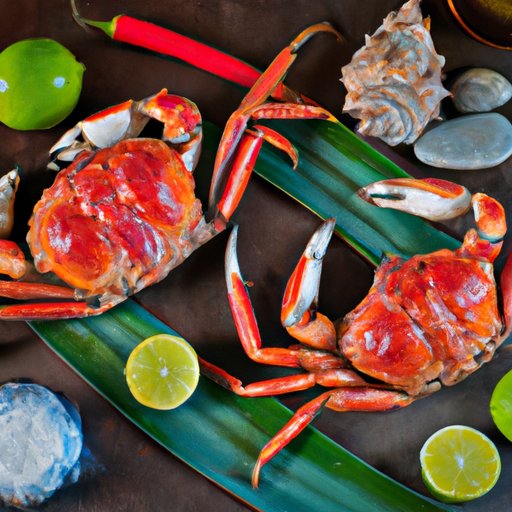
Introduction
Have you ever felt intimidated by a plate of crab? You’re not alone. Many people are unsure how to tackle this delicious seafood staple, and may even avoid it altogether. But with the right tools and techniques, eating crab can be a fun and delicious experience for all. In this beginner’s guide, we’ll walk you through everything you need to know about how to eat crab, from identifying the different parts to cracking and cleaning. So grab your bib, and let’s get cracking!
Understanding the Anatomy of Crab
The first step to eating crab is understanding what parts are edible. The most commonly eaten parts are the claws, legs, and body. The shells are not typically eaten, though some people do enjoy nibbling on the small bits of meat found in the legs. For a visual reference, we recommend checking out a diagram of crab before diving in.
Each part of the crab has a unique texture and flavor. The claws contain large, meaty chunks while the legs have smaller, delicate pieces. The body of the crab contains a mixture of meat and roe (eggs) that taste sweet and creamy.
Preparing and Cooking Crab
Before you can eat crab, you need to prepare it. Begin by cleaning the crab under running water to remove any excess dirt or sand. Next, use a sharp knife or pair of scissors to cut off the crab’s face, which includes the eyes, mouth, and gills. Once the face is removed, you can either cook the crab whole or remove the claws and legs for easier eating.
When it comes to cooking crab, there are a few different options. Some people prefer to boil it, while others steam or bake it. The method you choose will depend on your personal preference. If boiling, bring a pot of salted water to a boil and cook the crab for 10-12 minutes. If steaming, place the crab in a steamer basket and cook for 8-10 minutes. If baking, place the crab on a baking sheet and cook for 15-20 minutes at 375°F.
Regardless of cooking method, it’s important to add seasonings to enhance the flavor of the crab. Common options include Old Bay seasoning, garlic, butter, and lemon juice.
Different Types of Crab and Flavor Profiles
Not all crabs are created equal, and each type has a unique flavor profile. Some of the most popular types of crab include Dungeness, Blue Crab, and King Crab. Dungeness crabs are known for their sweet, delicate meat while Blue Crabs have a slightly briny and slightly sweet taste. King Crabs have a meatier flavor with a slightly sweet finish.
The type of crab you choose will also impact the sauces and side dishes you pair it with. For example, Dungeness crab pairs well with melted butter and garlic, while Blue Crab is often served with a spicy remoulade sauce. King Crab is traditionally served with drawn butter and lemon wedges.
Cracking and Cleaning Crab
Cracking and cleaning crab can be a messy process, but it’s worth it for the delicious meat inside. To crack the claws, use a crab cracker or nutcracker to break open the shell. To extract the meat, use a small fork or pick to gently pull it out. For the body, use a pair of scissors to cut open the shell and remove the meat and roe.
If you’re having trouble cracking the crab, there are some useful tools that can make the job easier. Crab scissors, for example, have serrated blades that can cut through the shell with ease. Crab picks are also helpful for removing meat from hard-to-reach areas.
Cultural and Regional Ways of Eating Crab
Eating crab is a popular pastime in many cultures and regions. In Maryland, for example, crab feasts are a summertime staple. The crabs are boiled with Old Bay seasoning and served on newspaper-covered tables. In Singapore, chili crab is a popular dish that features spicy tomato sauce and is often accompanied by fried buns for dipping.
If you’re curious about trying different cultural or regional styles of eating crab, there are many recipes available online. Some cultures often follow specific rituals, and it can be fun to replicate these at home to create an authentic dining experience.
Serving Crab
When it comes to serving crab, presentation is key. Many people enjoy serving crab in its natural shell, surrounded by garnishes like lemon wedges and fresh herbs. Other popular options include crab cakes, crab salads, and crab melts.
When it comes to beverages, light and refreshing options like beer or white wine pair well with crab. However, if you’re looking for something non-alcoholic, a cold glass of lemonade or sweet tea is a great option.
Summary
Learning how to eat crab can seem daunting at first, but with the right information and tools, it’s a fun and delicious experience for all. Remember, the most important thing is to enjoy the process and savor the delicious flavors of this iconic seafood favorite.
Conclusion
In summary, eating crab is a tasty and rewarding experience that anyone can enjoy. Understanding the anatomy of crab, preparing and cooking it correctly, and cracking and cleaning it with the right tools are all crucial steps to getting the most out of your crab feast. Whether you’re following a traditional cultural recipe or experimenting with different sauces and seasonings, there’s no wrong way to enjoy this delicious seafood favorite.




